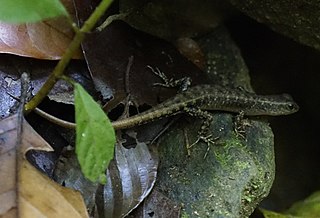
Sphenomorphus dussumieri, commonly known as Dussumier's forest skink and Dussumier's litter skink, is a species of skink, a lizard in the family Scincidae. The species is endemic to southern India.

Sphenomorphus sabanus is a species of skink in the family Scincidae. It is known commonly as the Sabah slender skink.

Otosaurus cumingii, commonly called Cuming's sphenomorphus or the Luzon giant forest skink, is a species of skink, a lizard in the family Scincidae. The species is endemic to the Philippines.

Tytthoscincus is a genus of skinks. Originally defined to include a few species from the Philippines, the genus now includes many species from South-East Asia in general.

Insulasaurus wrighti, also known commonly as Wright's sphenomorphus, is a species of skink, a lizard in the family Scincidae. The species is endemic to Palawan in the Philippines.
Parvoscincus beyeri, also known commonly as Beyer's sphenomorphus, is a species of skink, a lizard in the family Scincidae. The species is endemic to the Philippines.
Parvoscincus lawtoni is a species of lizard in the subfamily Sphenomorphinae of the family Scincidae (skinks). The species is endemic to the Philippines.
Parvoscincus tagapayo, the Aurora mountain skink, is a species of lizard in the family Scincidae. The species is endemic to the Philippines.

Pinoyscincus abdictus is a species of skink, a lizard in the family Scincidae. The species is endemic to the Philippines. There are two recognized subspecies.
Pinoyscincus coxi, Cox's sphenomorphus, is a species of skink, a lizard in the family Scincidae. The species is endemic to the Philippines. There are two recognized subspecies.

Pinoyscincus jagori, Jagor's sphenomorphus, is a species of skink, a lizard in the family Scincidae. The species is endemic to the Philippines. There are two recognized subspecies.

Pinoyscincus llanosi, also known commonly as the Leyte sphenomorphus, is a species of skink, a lizard in the family Scincidae. The species is endemic to the Philippines.
The Mindanao sphenomorphus is a species of skink, a lizard in the family Scincidae. The species is endemic to the Philippines.
Sphenomorphus alfredi is a species of skink, a lizard in the family Scincidae. The species is endemic to Malaysia near Mount Kinabalu, Sabah, and Borneo.
Sphenomorphus buettikoferi is a species of skink, a lizard in the family Scincidae. The species is endemic to the island of Borneo.
Sphenomorphus cranei, also known commonly as Crane's skink and Crane's forest skink, is a species of lizard in the family Scincidae. The species is endemic to the Solomon Islands.
Sphenomorphus derooyae is a species of skink, a lizard in the family Scincidae. The species is native to Oceania.

Sphenomorphus haasi is a species of skink, a lizard in the family Scincidae. The species is endemic to the island of Borneo, on which it is found in Malaysia and Indonesia.
Tytthoscincus butleri, also known commonly as Butler's forest skink, is a species of lizard in the family Scincidae. The species is native to Malaysia and Thailand.
Tytthoscincus ishaki, also known commonly as the Tioman Island forest skink, is a species of lizard in the family Scincidae. The species is endemic to Tioman Island in Malaysia.









